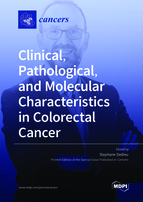Clinical, Pathological, and Molecular Characteristics in Colorectal Cancer
A special issue of Cancers (ISSN 2072-6694).
Deadline for manuscript submissions: closed (20 June 2022) | Viewed by 26904
Special Issue Editor
Interests: cancer; extracellular matrix; tumor microenvironment; endocytosis; peptide-based therapeutic approaches
Special Issues, Collections and Topics in MDPI journals
Special Issue Information
Dear Colleagues,
Colorectal cancer (CRC) is the third most diagnosed cancer worldwide, and the second leading cause of death in patients having cancer. Lifestyle, diet factors, obesity, family history or even pre-existing inflammatory diseases lead to increased risks of developing this heterogeneous malignant disease.
Carcinogenesis steps have commonly involved the growth and expansion of adenomatous polyps from normal colorectal epithelium to adenoma through a multistep process of several years. Many signaling pathways are altered during this transformation course that involves, certainly, hereditary factors, but mainly somatic sporadic mutations affecting both tumor suppressor genes and oncogenes (p53, APC, and KRAS from the most common recurrent somatic mutations). The chromosomal instability, CpG island methylation phenotype, and microsatellite instability (MSI) frequency are the three main routes leading to tumor transformation and progression.
The most common tumor-nodes-metastasis (TNM) staging system leading CRC patient treatment is not completely satisfactory because patients with similar histopathology may have various therapeutic responses and relapse frequency due to differential genetic and epigenetic profiles. New biomarkers such as Immunoscore™, gene signatures, and postoperative circulating tumor DNA (ctDNA) are promising tools to identify patients with a high risk of recurrence after primary tumor resection.
Patient prognosis has improved over the past few decades in developed countries, due to an improved health path and better awareness of the population to diagnosis, earlier and regular screening, and access to more effective targeted therapies. However, the 5-year survival rate of patients with stage IV remains under 10%. Drug development efforts are therefore mainly focused on patients having stage IV metastatic CRC. Although surgery is the primary curative treatment of early-stage patients and resectable metastasis, current treatments for unresectable metastatic CRC involve cytotoxic chemotherapies and targeted therapies, either alone or as a combination treatment. Approved targeted therapy includes angiogenesis inhibitors (bevacizumab, aflibercept, regorafenib), anti-EGFR monoclonal antibodies (cetuximab and panitumumab) in RAS wild-type tumor, and tyrosine kinase BRAF/MEK inhibitors (binimetinib and encorafenib) in BRAF mutated tumor.
The emergence and success of immunotherapies in other indications seem likely to change the game. However, despite a wide variety of immunotherapy approaches in early-phase clinical trials, clinical benefits for CRC patients are currently limited to patients with a microsatellite instability-high (MSI-H) or mismatch repair-deficient (dMMR) profile, representing about 5% of metastatic CRC. The trend is, however, to position immune-oncology drugs in combination with currently available treatments to penetrate the first lines of therapy and improve the outcome of CRC patients.
Better understanding the specific clinical and/or molecular features in CRC should therefore improve patient stratification and follow-up, together with treatment algorithms, especially when there is a significant unmet medical need.
This will require the identification of new biomarkers and therapeutic targets to overcome current barriers and limitations.
Prof. Stephane Dedieu
Guest Editor
Manuscript Submission Information
Manuscripts should be submitted online at www.mdpi.com by registering and logging in to this website. Once you are registered, click here to go to the submission form. Manuscripts can be submitted until the deadline. All submissions that pass pre-check are peer-reviewed. Accepted papers will be published continuously in the journal (as soon as accepted) and will be listed together on the special issue website. Research articles, review articles as well as short communications are invited. For planned papers, a title and short abstract (about 100 words) can be sent to the Editorial Office for announcement on this website.
Submitted manuscripts should not have been published previously, nor be under consideration for publication elsewhere (except conference proceedings papers). All manuscripts are thoroughly refereed through a single-blind peer-review process. A guide for authors and other relevant information for submission of manuscripts is available on the Instructions for Authors page. Cancers is an international peer-reviewed open access semimonthly journal published by MDPI.
Please visit the Instructions for Authors page before submitting a manuscript. The Article Processing Charge (APC) for publication in this open access journal is 2900 CHF (Swiss Francs). Submitted papers should be well formatted and use good English. Authors may use MDPI's English editing service prior to publication or during author revisions.
Keywords
- CRC
- diagnostics
- prognosis
- recurrence
- metastasis
- targeted therapy
- immunotherapy
- tumor microenvironment
- signaling pathways
- mutations
- methylation phenotype
- microsatellite instability







